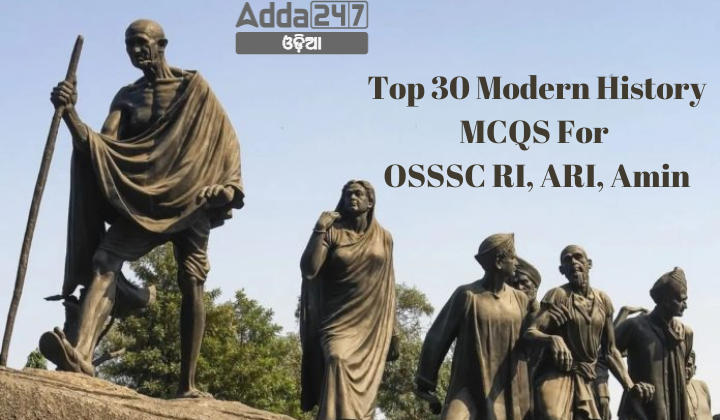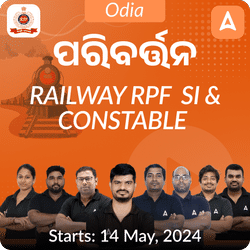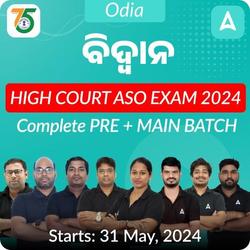Preparing for competitive exams such as OSSSC RI (Revenue Inspector), ARI (Assistant Revenue Inspector), Amin, SFS, or ICDS Supervisor often requires a strong grasp of historical events. Modern history, especially, forms a significant part of the syllabus, covering crucial periods and events that shaped the world as we know it today. To aid in your preparation, here are 30 multiple-choice questions (MCQs) focusing on modern history:
Top 30 Modern History MCQs For OSSSC RI, ARI, Amin, SFS, ICDS Supervisor
- Who were the primary adversaries in the Battle of Plassey?
A. British East India Company vs. Mughal Empire
B. British East India Company vs. French East India Company
C. British East India Company vs. Nawab of Bengal
D. British East India Company vs. Maratha Empire
Answer: C. British East India Company vs. Nawab of Bengal - Which British officer led the East India Company forces in the Battle of Plassey?
A. Siraj-ud-Daulah
B. Mir Jafar
C. Robert Clive
D. Warren Hastings
Answer: C. Robert Clive - What was the primary cause of the Battle of Plassey?
A. Dispute over territory between British and French
B. Disagreement over trade routes in Bengal
C. British fortification of Calcutta without Nawab’s permission
D. British refusal to pay taxes to Nawab of Bengal
Answer: C. British fortification of Calcutta without Nawab’s permission - Who betrayed Nawab Siraj-ud-Daulah during the Battle of Plassey?
A. Rai Durlabh
B. Robert Clive
C. Mir Jafar
D. Jagat Seth
Answer: C. Mir Jafar - What was the immediate aftermath of the Battle of Plassey for the British East India Company?
A. Loss of influence in Bengal
B. Strengthened control over Bengal
C. Establishment of French dominance in Bengal
D. Withdrawal from Indian subcontinent
Answer: B. Strengthened control over Bengal - Who were the primary belligerents in the Third Battle of Panipat?
A) Maratha Empire and Mughal Empire
B) Maratha Empire and Durrani Empire
C) Mughal Empire and British East India Company
D) Maratha Empire and Sikhs
Answer: B) Maratha Empire and Durrani Empire - Who was the Commander-in-chief of the Maratha Army during the battle?
A) Balaji Bajirao
B) Shivaji Bhosle
C) Sadashivrao Bhau
D) Nana Fadnavis
Answer: C) Sadashivrao Bhau - Where did the Third Battle of Panipat take place?
A) Delhi
B) Pune
C) Panipat
D) Lahore
Answer: C) Panipat - When did the Third Battle of Panipat occur?
A) 1760
B) 1761
C) 1757
D) 1770
Answer: B) 1761 - Which Afghan ruler led the Durrani Empire during the battle?
A) Ahmad Shah Durrani
B) Babur
C) Sher Shah Suri
D) Aurangzeb
Answer: A) Ahmad Shah Durrani - What was the outcome of the Third Battle of Panipat?
A) Victory for the Marathas
B) Victory for the British
C) Victory for the Afghans
D) Stalemate
Answer: C) Victory for the Afghans - Which Indian ruler allied with Ahmad Shah Durrani against the Marathas?
A) Chhatrapati Shivaji Maharaj
B) Shuja-ud-Daulah
C) Maharaja Ranjit Singh
D) Rana Pratap
Answer: B) Shuja-ud-Daulah - What was one of the reasons for the Afghan victory at Panipat?
A) Numerical superiority
B) Technological advantage
C) Naval dominance
D) Diplomatic alliances
Answer: A) Numerical superiority - How did the Battle of Panipat impact the Maratha Empire immediately after?
A) Expansion into South India
B) Establishment of a strong navy
C) Loss of leadership and territory
D) Alliance with the British
Answer: C) Loss of leadership and territory - Who was reinstated as the Mughal Emperor in Delhi after the battle?
A) Akbar
B) Aurangzeb
C) Shah Alam II
D) Bahadur Shah II
Answer: C) Shah Alam II - Who was Hyder Ali?
A. A British diplomat
B. Commander-in-chief of the Mysore army
C. French general
D. Portuguese trader
Answer: B. Commander-in-chief of the Mysore army - What position did Hyder Ali achieve in the Mysore state under Krishnaraja Wodeyar II?
A. Prime Minister
B. Chief Minister
C. Commander of the Navy
D. Treasurer
Answer: B. Chief Minister - How did Hyder Ali change the Mysore army?
A. Introduced European-style training
B. Introduced Chinese war tactics
C. Adopted Mongol cavalry tactics
D. Trained soldiers in African warfare
Answer: A. Introduced European-style training - Which war saw the Treaty of Madras signed?
A. First Anglo-Mysore War
B. Second Anglo-Mysore War
C. Third Anglo-Mysore War
D. Fourth Anglo-Mysore War
Answer: A. First Anglo-Mysore War - What event led to the outbreak of the First Anglo-Mysore War?
A. Hyder Ali’s attack on Madras
B. British refusal to support Mysore against Marathas
C. Nizam’s invasion of Mysore
D. French invasion of British territories
Answer: B. British refusal to support Mysore against Marathas - Who replaced Hyder Ali after his death during the Second Anglo-Mysore War?
A. Tipu Sultan
B. Krishnaraja Wodeyar II
C. Sir Eyre Coote
D. Marquess Wellesley
Answer: A. Tipu Sultan - Which treaty ended the Second Anglo-Mysore War?
A. Treaty of Madras
B. Treaty of Mangalore
C. Treaty of Srirangapatna
D. Treaty of Arcot
Answer: B. Treaty of Mangalore - What alliance did Hyder Ali form during the Second Anglo-Mysore War?
A. With the French and British
B. With the Marathas and Nizam
C. With the Dutch and Portuguese
D. With the Spanish and Italians
Answer: B. With the Marathas and Nizam - Which battle was a part of the First Anglo-Mysore War?
A. Battle of Plassey
B. Battle of Chengam
C. Battle of Panipat
D. Battle of Buxar
Answer: B. Battle of Chengam - What caused Hyder Ali to declare war on the British during the Second Anglo-Mysore War?
A. British attack on Madras
B. French invasion of Mysore
C. British refusal to return territories
D. British attack on Mahe
Answer: D. British attack on Mahe - What were the primary causes of the Third Anglo-Mysore War?
A. Tipu Sultan’s refusal to accept the Treaty of Mangalore
B. British dissatisfaction with Tipu’s alignment with the French
C. Tipu Sultan’s attack on the Marathas
D. British desire for territorial expansion in South India
Answer: B. British dissatisfaction with Tipu’s alignment with the French - Who declared war first in the Third Anglo-Mysore War?
A. Lord Cornwallis
B. Tipu Sultan
C. Nizam of Hyderabad
D. Marathas
Answer: A. Lord Cornwallis - What was the outcome of the Treaty of Seringapatam (1792)?
A. Tipu Sultan regained all lost territories
B. Tipu Sultan paid war indemnity to the Marathas
C. Tipu Sultan ceded half of his kingdom to the British
D. Tipu Sultan allied with the French
Answer: C. Tipu Sultan ceded half of his kingdom to the British - What led to the Fourth Anglo-Mysore War in 1799?
A. Tipu Sultan’s rejection of the Subsidiary Alliance
B. British invasion of Mysore
C. Marathas’ attack on Seringapatam
D. Tipu Sultan’s death
Answer: A. Tipu Sultan’s rejection of the Subsidiary Alliance - How did the Fourth Anglo-Mysore War end?
A. Tipu Sultan fled to France
B. Mysore became a British colony
C. Tipu Sultan died defending Seringapatam
D. Nizam of Hyderabad became ruler of Mysore
Answer: C. Tipu Sultan died defending Seringapatam
















